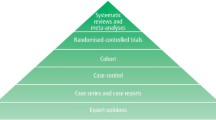Abstract
Data sources Cochrane Oral Health Group specialised register of RCT, limited to the Journal of Clinical Periodontology, Journal of Periodontology and Journal of Periodontal Research from 1996 to 1998.
Study selection Studies included were RCT of treatment conducted in humans and with a full journal publication available.
Data extraction and synthesis Information was extracted about randomisation, allocation concealment methods and the blinding of patient, caregiver and examiner. This was conducted independently by two reviewers.
Results A total of 91% of trials were described as randomised, of which 17% had adequate methods of randomisation and 7% adequate allocation concealment. Blinding was adequate for the caregiver in 17% and for the examiner in 55% of studies. A clear accounting of all participants was present in 56% of reports.
Conclusions The quality of periodontology RCT, judged by their publications, frequently does not meet recommended standards. If this quality is reflected in actual study conduct, fundamental errors could have a significant impact on the outcomes of these trials. It is likely that other fields of dentistry are similarly affected.
Similar content being viewed by others
Commentary
This is a very well-conducted review of the quality of reporting of periodontology RCT and it raises a number of interesting points. First, it is important to stress (as do the authors) that the study relates to the quality of reporting and not the actual conduct of the trials. As discussed, however, if the quality of reporting does reflect the conduct of the study, there could be a significant impact on their outcomes. Those planning research should read the CONSORT guidelines for reporting trials (www.consort-statement.org) before they begin.
The authors used the Cochrane Oral Health Group's specialised register of RCT to identify trials. This is an important and developing resource and should be the first point of contact for this type of study: Medline searches are known to detect on average only 51% (range 17–82%) of RCTs.1
The finding that only 17% of studies report adequate randomisation is similar to a study2 comparing medicine and dentistry RCT which found only 28% and 27%, respectively, describing adequate randomisation. More worrying is the low figure of 7% for adequate allocation concealment which could result in selection bias and overestimation of the treatment effect.
Blinding of outcome assessment and the handling of dropouts are also important to the validity of any trial. Where the reviewers judged it possible to achieve, the level of examiner blinding was only 55% and outcomes typically assessed in periodontology such as probing changes are particularly prone to this type of bias. Very few studies used the currently recommended approaches of intent-to-treat and worst-case scenario analysis to assess the impact of missing patient data. This could lead to an overestimation of treatment effect, as with selection bias as a result of poor allocation concealment.
As periodontology is the dental discipline that produces the greatest number of RCT,3 one would hope that the greater experience with this study design might result in better reporting. The results of this review suggest otherwise, however, and it is time that the dental research community began to address this issue. The adoption of CONSORT by more dental journals would be a first step, but more training in study design is also required.
Practice point
-
The quality of RCT reporting in periodontology (and probably the other dental disciplines) needs to improve.
References
Dikersin K, Scherer R, Lefebvre C . Identifying relevant studies for systematic reviews. Br Med J 1994; 309:1286–1291.
Sjögren P, Halling A . Quality of reporting of randomised clinical trials in dental and medical research. Br Dent J 2002; 192:100–103.
Niederman R, Chen L, Murzyn L, Conway S . Benchmarking the dental randomised controlled literature on MEDLINE. EBD 2002; 3:5–9.
Author information
Authors and Affiliations
Additional information
Address for correspondence: Ian Needleman, Department of Periodontology, Eastman Dental Institute for Oral Health Care Sciences, University College London, 256 Gray's Inn Road, London WC1X 8LD, UK. E-mail: i.needleman@eastman.ucl.ac.uk
Montenegro R, Needleman I, Moles D, Tonetti M. Quality of RCTs in periodontology. A systematic review. J Dent Res 2002; 81:866–870
Rights and permissions
About this article
Cite this article
Richards, D. RCTs in periodontology do not meet current recommendations on quality. Evid Based Dent 4, 3 (2003). https://doi.org/10.1038/sj.ebd.6400163
Published:
Issue Date:
DOI: https://doi.org/10.1038/sj.ebd.6400163
This article is cited by
-
Quality of reporting randomised controlled trials in major dental journals suboptimal
Evidence-Based Dentistry (2011)



